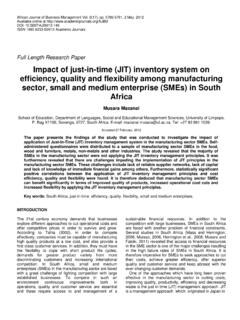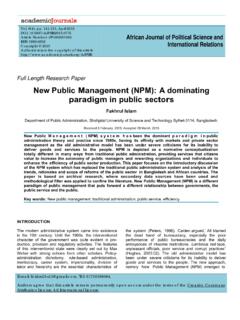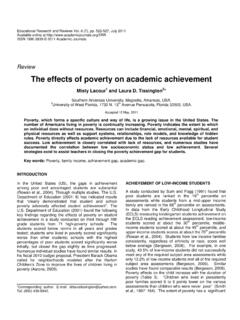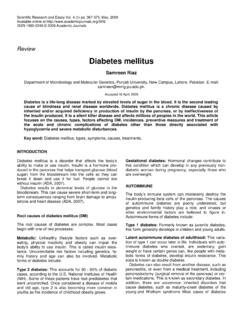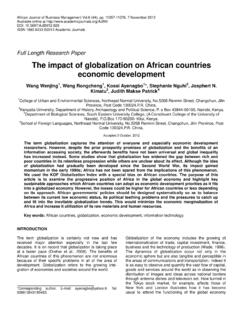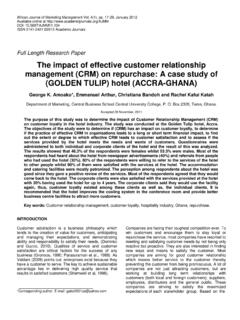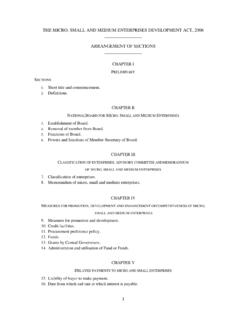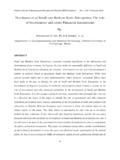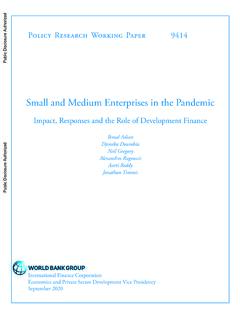Transcription of A literature review of small and medium enterprises (SME ...
1 African Journal of Business Management Vol. 6(21), pp. 6324-6330, 30 May, 2012 Available online at DOI: ISSN 1993-8233 2012 Academic Journals review A literature review of small and medium enterprises (SME) risk management practices in South Africa Yolande Smit* and J. A. Watkins Department of Internal Auditing and Management Accounting, Cape Peninsula University of Technology, South Africa. Accepted 3 January, 2012 The inherent characteristics of small and medium enterprises (SMEs) afford these enterprises the potential to absorb unskilled labour and to nurture and develop entrepreneurial skills. However, in the South African economy, these benefits are not forthcoming due to the high failure rate of SMEs. The impediments to SME success includes numerous and varied obstacles.
2 Studies conducted confirmed SME owner-managers ignorant pertaining to the risks their enterprise face with risk management techniques deployed reactively and ineffectively. By embedding a structured approach to enterprise risk management within SMEs, potential benefits such as reducing the over-management of risks and organisational alignment towards the SME s vision can be realised. Key words: small and medium enterprises (SMEs), risk, risk management, strategic risk management. INTRODUCTION small and medium enterprises (SMEs) operate in the same environment as their larger counterparts, but without the associated benefits such as adequate capital and extended human resources of the larger organisations. SMEs encounter increasing competitive pressure fuelled by globalisation, legislation and the relaxing of trade barriers, as well as an increase in market expansion due to emerging technologies and innovation.
3 small and medium enterprises often flourish on their adaptability and agility such as their close proximity to their customers, their openness towards new ways of working, and their risk taking approach, but many micro, small and medium enterprise are susceptible to major external shocks (Berry, 2002; Laforet and Tann, 2006). Although SMEs experience difficulties in absorbing and coping with these obstacles, they need to develop an ability to deal with the ever increasing challenges, that is, risks faced by the organisation (Leopoulos, 2006). SME owner-managers need to escalate the importance of risk identification and minimisation in their *Corresponding author. E-mail: Tel: +27 (0) 21 864 5264, +27 (0) 84 423 275.
4 Fax: +27 (0) 21 864 5262. organisations or they can suffer catastrophic consequences if they are ill prepared for the outcome of a possible risk. This entails that entrepreneurs in SMEs need to be conversant with risk identification and analysis to manage risks from a diverse range of sources (Schultz, 2001). By incorporating risk management into SMEs operations, SMEs are better equipped to exploit their resources, thereby enabling organisations to transform an expenditure activity into an activity that can yield a positive return (Kirytopoulos et al., 2001; Banham, 2004). DEFINING small and medium enterprises (SMEs) Although the term SME or SMME is used inter- changeably worldwide, there is no common definition of these terms.
5 The geographical placement of SMEs as well as country specific legislation influences the numerous SME definitions (Leopoulos, 2006). In South Africa, the National small Business Act 102 of 1996 (South Africa, 1996) amended by Act 29 of 2004 (South Africa, 2004) categorise small organisations into four categories namely micro enterprises , including survivalist enterprises ; very small enterprises ; small enterprises ; and medium enterprises . The differentiating factor between these categories, excluding micro enterprises , is the number of employees. For micro enterprises , the criterion is turnover level (South Africa, 1996, 2004; Von Broembsen, 2003). Importance of small and medium enterprises (SMEs) to the economy The importance of small businesses is recognised in numerous African countries such as Togo, Uganda, Ghana, Cote d Lvoire, Nigeria, Kenya, Malawi, Burkina Faso, as well as others.
6 According to Rwigema and Karungu (1999), SMEs are dominant in numbers in most economies. In First World countries like the United States of America and the United Kingdom, small enterprises play an important role in the economy, accounting for an estimated one third of industrial employment and a lower percentage of output. In Third World countries where SMEs dominate economically active enterprises , the SMEs prosperity is considered far more important than in First World countries (Rwigema and Karungu, 1999). The activities of SME enterprises in Africa (Rogerson, 2001a), is of vital importance for the promotion of economic growth, job creation and the mitigation of poverty. However, research conducted on SMEs in Africa by Mead and Liedholm (1998) confirmed that on average, there are more SME closures than expansions, with approximately only 1% of micro enterprises growing from five or less employees to ten or more.
7 It has long been debated that SMEs are pivotal to employment creation and economic growth, particularly in countries such as South Africa that has a high unemployment rate, estimated at up to 40% (Friedrich, 2004; Watson, 2004). Upgrading the roles of the SME sector in the South African economy to improve economic growth through increasing competitiveness, and by generating employ- ment and redistributing income (Rogerson, 2004, 2006), has been the focus of new development policies since the democratic transition (Berry et al., 2002; GCIS, 2002). In order to aid in the facilitation of the SME environment, the South African government tabled the National small Business Act of 1996 amended with Act 29 of 2004 to provide equal standing to SME enterprises (Rwigema and Venter, 2004; Ntsika, 2001) in South Africa s economy.
8 The vital role the SME sector plays in the South African economy in addressing sustainable development, was highlighted by the 2003 Human Development Report (UNDP, 2003) for South Africa (Rogerson, 2004). In South Africa, it is estimated that 90% of all formal businesses are small , medium or micro enterprises (Rwigema and Karungu, 1999). The SME sector is one of the largest contributors to the South African economy. The SME is not only seen as an employment creator, but this sector also acts as an absorbent of retrenched people coming from the private and public sector Smit and Watkins 6325 (Ntsika, 2001). Although the SME sector is responsible for 75% of new jobs, largely due to the emergence of new micro enterprise formations, it compares poorly to Asian countries where SME employment contribution is estimated at 80% (Friedrich, 2004; Watson and Godfrey, 1999).
9 Even in countries less developed than South Africa, their SME sector contributes a much higher proportion to the GDP and employment (UNDP, 2003; OECD, 19971 cited by Watson and Godfrey, 1999). It is noted that the majority of South African SMEs are micro and survivalist enterprises which show no signs of enterprise growth due to inadequate firm dynamics, resulting in SMEs conservative contribution to employ- ment compared to other countries. Even in dynamic South African SMEs, it seems that a jobless growth strategy (Kesper, 2000) is employed. The South African government has identified the SME sector as the means to achieve accelerated economic growth. However, this objective was not achieved partly due to the high failure rate of 80% of enterprises (Watson, 2004; Van Niekerk, 2005) in the SME sector.
10 As SMEs growth depends to a larger extent on the macro economic growth, it can be said that the slack micro economic growth of the past few years has inhibited entrepreneurial performance and therefore SMEs to grow to their full potential (Watson, 2004; Berry et al., 2002). SME failure can further be partly ascribed to the lack of management skills. South African SMEs do not aspire to corporate governance best practices such as the non-compulsory implementation of King III (King, 2009). Risk management, a component of King III, is therefore, also regarded as an optional organisational activity, and not as a vital component to organisational success. Critical success factors for small and medium enterprises (SMEs) Caution should be levied against viewing SMEs as smaller versions of larger enterprises as SMEs do not in any regard resemble large organisations.
